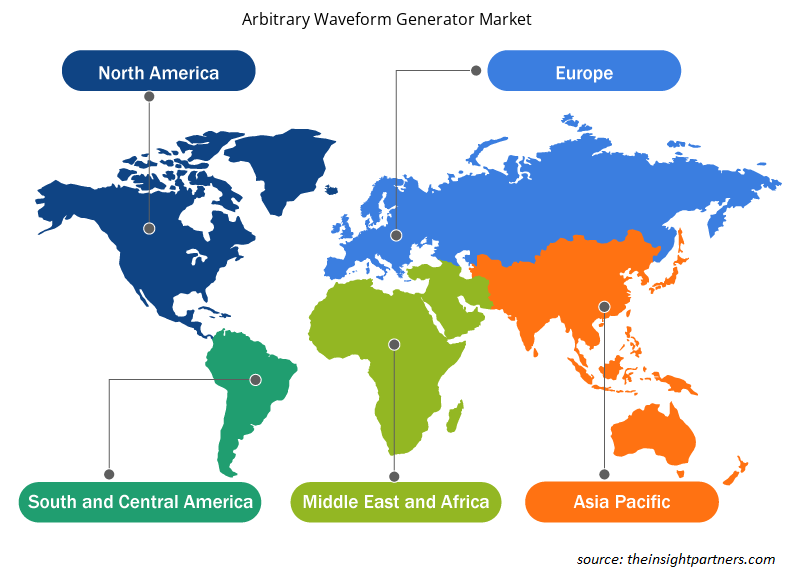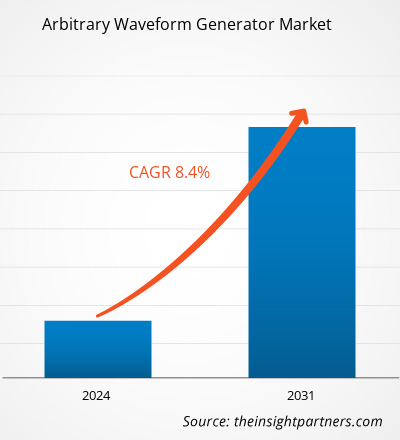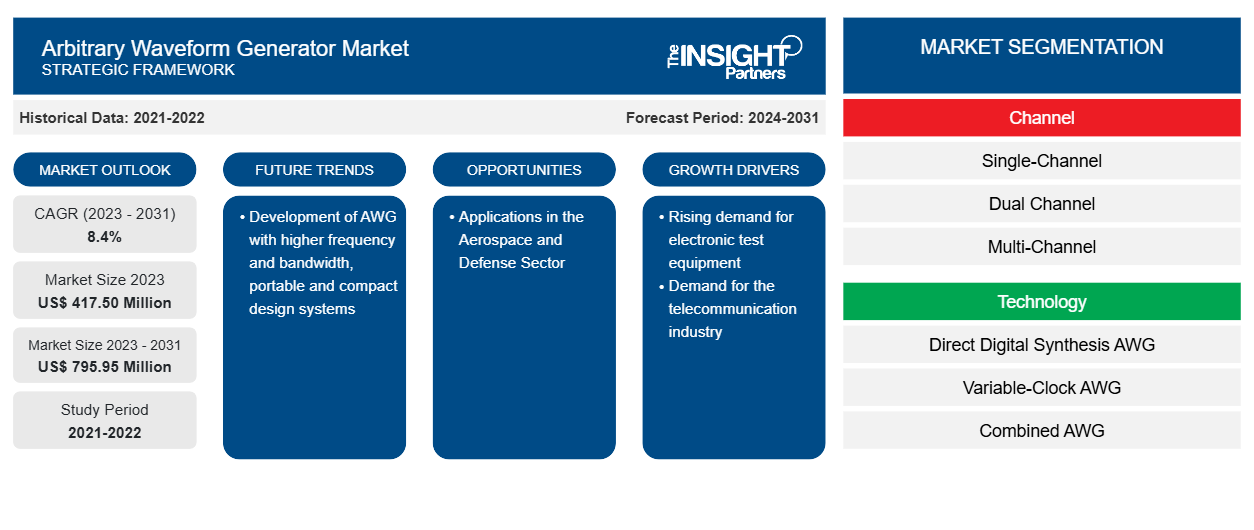Der Markt für Arbiträrwellenformgeneratoren soll von 417,50 Millionen US-Dollar im Jahr 2023 auf 795,95 Millionen US-Dollar im Jahr 2031 anwachsen. Der Markt wird zwischen 2023 und 2031 voraussichtlich eine durchschnittliche jährliche Wachstumsrate von 8,4 % verzeichnen. Die Entwicklung von Arbiträrwellenformgeneratoren mit höherer Frequenz und Bandbreite sowie tragbare und kompakte Designsysteme dürften weiterhin ein wichtiger Trend auf dem Markt bleiben.
Arbiträrwellenformgenerator-Marktanalyse
Wenn Messprobleme auftreten, die kompliziertere Antriebssignale als reguläre periodische Signale erfordern, bieten Arbiträrsignalgeneratoren (AWGs) eine Lösung. AWGs werden in zahlreichen Anwendungen eingesetzt, die spezifische Wellenformen erfordern. Diese sind in vielen Bereichen der Elektronikindustrie zu finden. Dank ihrer großen Flexibilität können moderne Arbiträrsignalgeneratoren äußerst spezifische Wellenformen erzeugen, mit denen sich eine Vielzahl von Anwendungen testen lässt. AWGs sind häufig in modernen digitalen Oszilloskopen zu finden.
Marktübersicht für Arbiträrwellenformgeneratoren
Mit der zunehmenden Komplexität in der Elektronik-, Halbleiter- und Telekommunikationsbranche steigt der Bedarf an verschiedenen Testgeräten, wie z. B. dem Arbiträrwellenformgenerator, um die Funktionalität der Geräte zu testen. Mit der Verbreitung von 5G und der kontinuierlichen Entwicklung der Telekommunikationsinfrastruktur spielt AWG eine entscheidende Rolle bei der Entwicklung von Kommunikationssystemen und beim Testen der Signalverarbeitung.
Passen Sie diesen Bericht Ihren Anforderungen an
Sie erhalten kostenlose Anpassungen an jedem Bericht, einschließlich Teilen dieses Berichts oder einer Analyse auf Länderebene, eines Excel-Datenpakets sowie tolle Angebote und Rabatte für Start-ups und Universitäten.
-
Holen Sie sich die wichtigsten Markttrends aus diesem Bericht.Dieses KOSTENLOSE Beispiel umfasst eine Datenanalyse von Markttrends bis hin zu Schätzungen und Prognosen.
Markttreiber und Chancen für Arbiträrwellenformgeneratoren
Steigende Nachfrage nach elektronischen Testgeräten begünstigt den Markt
Die elektronische Test- und Messausrüstung (T&M) wächst, angetrieben von neuen digitalen Hochgeschwindigkeitsstandards, Rechenzentren, autonomem Fahren, 5G, Internet der Dinge (IoT) und Stromanwendungen. Die Technologien , die die Phasen der Produktlebenszyklusentwicklung, -herstellung und -bereitstellung durchlaufen, haben die nächste Wachstumswelle eingeleitet. Die Nachfrage wird aufgrund der zunehmenden Komplexität und technologischen Konvergenz in allen Branchen steigen, wobei die Branchen Industrie und Automobil das größte Wachstum verzeichnen und die Kommunikations-, Halbleiter- und Computerbranche die größten Aussichten bieten. Angesichts der physikalischen Grenzen der aktuellen Testinstrumente können die Übertragungsgeschwindigkeiten nicht mit der steigenden Nachfrage nach schnelleren Datenübertragungsraten in Telekommunikations- und Rechenzentren Schritt halten. Dies hat zu einem Anstieg des Marktbedarfs an Arbiträrsignalgeneratoren geführt.IoT), and power applications. The lifecycle development, manufacture, and deployment have started the next wave of growth. Demand will increase across all verticals due to increased complexity and technological convergence, with the industrial and automotive verticals seeing the greatest growth and the communications, semiconductor, and computer industries offering the biggest prospects. With the current test instruments' physical limits, transmission speeds cannot keep up with the increasing demand for faster data transfer rates in telecom and data centers. This has led to an increase in the market's need for arbitrary waveform generators.
Anwendungen im Luft- und Raumfahrt- sowie Verteidigungssektor
Um zu bestätigen, dass ihr Radar Ziele genau verarbeitet, und um die Wirksamkeit des Basisbands zur Mikrowellenübertragung in der Umwandlungskette zu beurteilen, müssen Radarsystementwickler Testwellenformen bereitstellen. JTRS erfordert schmalbandige, frequenzagile Übertragungen für Kommunikationssysteme. Die Entwickler von Satellitenkommunikationssystemen müssen sich mit wachsenden Informationsbandbreiten auseinandersetzen. Entwickler müssen hochpräzise Signale erzeugen und Referenzwellenformen für all diese Anwendungen simulieren, was einen breitbandigen Arbiträrwellengenerator erfordert. Die wichtigsten neuen Anwendungen für AWG im Luft- und Raumfahrt- und Verteidigungssektor sind Radartests, Satellitentests, militärische Kommunikation, HF-Umgebungssimulation und allgemeine Empfängertests.baseband to microwave up the conversion chain, radar system designers must provide test waveforms. JTRS demands narrowband frequency agile transmissions for communication systems. The designers of satellite communication systems must deal with expanding information bandwidths. Designers need to produce high-fidelity signals in addition to simulating reference waveforms for all of these applications, which calls for a wideband arbitrary waveform generator. The major emerging applications for AWG in the aerospace and defense sector are Radar tests, satellite tests, military communications, RF environment simulation, and general receiver tests.
Marktbericht zum Arbiträrwellenformgenerator – Segmentierungsanalyse
Wichtige Segmente, die zur Ableitung der Marktanalyse für Arbiträrwellengeneratoren beigetragen haben, sind Kanal, Technologie, Bandbreite und Anwendung.
- Basierend auf dem Kanal ist der Markt für beliebige Wellenformgeneratoren in Einkanal-, Zweikanal- und Mehrkanal-Segmente unterteilt. Das XX-Segment hatte im Jahr 2023 den größten Anteil.
- Basierend auf der Technologie ist der Markt in AWG mit direkter digitaler Synthese, AWG mit variabler Taktung und kombinierte AWG unterteilt.AWG, variable-clock AWG, and combined AWG.
- Basierend auf der Bandbreite ist der Markt in unter 1 GHz, 1–5 GHz, 5–10 GHz, 10–25 GHz, 25–32 GHz, 32–50 GHz und über 50 GHz unterteilt.
- Basierend auf der Anwendung wird der Markt in Telekommunikation, Bildung, Gesundheitswesen, Elektronik und Sonstiges unterteilt.
Marktanteilsanalyse für Arbiträrwellenformgeneratoren nach Geografie
Der geografische Umfang des Marktberichts für Arbiträrwellenformgeneratoren ist hauptsächlich in fünf Regionen unterteilt: Nordamerika, Asien-Pazifik, Europa, Naher Osten und Afrika sowie Süd- und Mittelamerika.
Nordamerika hält im Jahr 2023 einen bedeutenden Anteil am Markt für beliebige Wellenformgeneratoren. In der Region sind wichtige Akteure auf dem Markt stark vertreten. Darüber hinaus unterstützen die technologische Landschaft und Investitionen in Forschung und Entwicklung sowie Gerätetests das Wachstum von beliebigen Wellenformgeneratoren auf dem Markt weiter.
Regionale Einblicke in den Markt für Arbiträrwellenformgeneratoren
Die regionalen Trends und Faktoren, die den Markt für Arbiträrwellenformgeneratoren während des Prognosezeitraums beeinflussen, wurden von den Analysten von Insight Partners ausführlich erläutert. In diesem Abschnitt werden auch die Marktsegmente und die Geografie von Arbiträrwellenformgeneratoren in Nordamerika, Europa, im asiatisch-pazifischen Raum, im Nahen Osten und Afrika sowie in Süd- und Mittelamerika erörtert.

- Erhalten Sie regionale Daten zum Arbiträrwellenformgenerator-Markt
Umfang des Marktberichts über Arbiträrwellenformgeneratoren
| Berichtsattribut | Details |
|---|---|
| Marktgröße im Jahr 2023 | 417,50 Millionen US-Dollar |
| Marktgröße bis 2031 | 795,95 Millionen US-Dollar |
| Globale CAGR (2023 - 2031) | 8,4 % |
| Historische Daten | 2021-2022 |
| Prognosezeitraum | 2024–2031 |
| Abgedeckte Segmente |
Nach Kanal
|
| Abgedeckte Regionen und Länder |
Nordamerika
|
| Marktführer und wichtige Unternehmensprofile |
|
Dichte der Marktteilnehmer für Arbiträrwellengeneratoren: Die Auswirkungen auf die Geschäftsdynamik verstehen
Der Markt für Arbiträrwellenformgeneratoren wächst rasant, angetrieben durch die steigende Endverbrauchernachfrage aufgrund von Faktoren wie sich entwickelnden Verbraucherpräferenzen, technologischen Fortschritten und einem größeren Bewusstsein für die Vorteile des Produkts. Mit steigender Nachfrage erweitern Unternehmen ihr Angebot, entwickeln Innovationen, um die Bedürfnisse der Verbraucher zu erfüllen, und nutzen neue Trends, was das Marktwachstum weiter ankurbelt.
Die Marktteilnehmerdichte bezieht sich auf die Verteilung der Firmen oder Unternehmen, die in einem bestimmten Markt oder einer bestimmten Branche tätig sind. Sie gibt an, wie viele Wettbewerber (Marktteilnehmer) in einem bestimmten Marktraum im Verhältnis zu seiner Größe oder seinem gesamten Marktwert präsent sind.
Die wichtigsten auf dem Markt für Arbiträrwellenformgeneratoren tätigen Unternehmen sind:
- B&K Precision Corporation
- BERKELEY NUCLEONICS CORPORATION
- KEYSIGHT-TECHNOLOGIEN
- Pico-Technologie
- Rohde & Schwarz
- SHF Communication Technologies AG
Haftungsausschluss : Die oben aufgeführten Unternehmen sind nicht in einer bestimmten Reihenfolge aufgeführt.

- Überblick über die wichtigsten Akteure auf dem Markt für Arbiträrwellenformgeneratoren
Marktnachrichten und aktuelle Entwicklungen für Arbiträrwellengeneratoren
Der Markt für Arbiträrwellengeneratoren wird durch die Erfassung qualitativer und quantitativer Daten nach Primär- und Sekundärforschung bewertet, die wichtige Unternehmensveröffentlichungen, Verbandsdaten und Datenbanken umfasst. Nachfolgend sind einige der Entwicklungen auf dem Markt für Arbiträrwellengeneratoren aufgeführt:
- Berkeley Nucleonics, ein Vorreiter auf dem Gebiet der elektronischen Instrumentierung, hat seinen neuesten HF-/Mikrowellen-Signalgenerator vorgestellt: das Modell 870A. Dieses fortschrittliche Instrument ist für die anspruchsvollsten Anwendungen konzipiert und bietet außergewöhnliche Leistung mit ultrahoher Agilität und ultraniedrigem Phasenrauschen und deckt einen beeindruckenden Frequenzbereich von 100 kHz bis 50 GHz ab. (Quelle: Berkeley Nucleonics, Pressemitteilung, September 2023)
- Keysight Technologies, Inc. (NYSE: KEYS), ein führendes Technologieunternehmen, das Unternehmen, Dienstleistern und Regierungen hilft, Innovationen voranzutreiben, um die Welt zu vernetzen und abzusichern, hat den ersten Arbiträrwellengenerator (AWG) mit 256 GSa/s angekündigt – Keysights M8199A – mit 65 GHz analoger Bandbreite in einem kompakten AXIe-Modul mit 2 Steckplätzen. (Quelle: Keysight Technologies, Inc, Pressemitteilung, September 2020)
Marktbericht zum Arbiträrwellenformgenerator – Abdeckung und Ergebnisse
Der Bericht „Marktgröße und Prognose für Arbiträrwellenformgeneratoren (2021–2031)“ bietet eine detaillierte Analyse des Marktes, die die folgenden Bereiche abdeckt:
- Marktgröße und Prognose für Arbiträrwellenformgeneratoren auf globaler, regionaler und Länderebene für alle wichtigen Marktsegmente, die im Rahmen des Berichts abgedeckt sind
- Markttrends für Arbiträrwellenformgeneratoren sowie Marktdynamik wie Treiber, Einschränkungen und wichtige Chancen
- Detaillierte PEST/Porters Five Forces- und SWOT-Analyse
- Marktanalyse für Arbiträrwellenformgeneratoren mit wichtigen Markttrends, globalen und regionalen Rahmenbedingungen, wichtigen Akteuren, Vorschriften und aktuellen Marktentwicklungen
- Branchenlandschaft und Wettbewerbsanalyse, die die Marktkonzentration, Heatmap-Analyse, prominente Akteure und aktuelle Entwicklungen auf dem Markt für Arbiträrwellenformgeneratoren umfasst
- Detaillierte Firmenprofile
- Historische Analyse (2 Jahre), Basisjahr, Prognose (7 Jahre) mit CAGR
- PEST- und SWOT-Analyse
- Marktgröße Wert/Volumen – Global, Regional, Land
- Branchen- und Wettbewerbslandschaft
- Excel-Datensatz
Aktuelle Berichte
Verwandte Berichte
Erfahrungsberichte
Grund zum Kauf
- Fundierte Entscheidungsfindung
- Marktdynamik verstehen
- Wettbewerbsanalyse
- Kundeneinblicke
- Marktprognosen
- Risikominimierung
- Strategische Planung
- Investitionsbegründung
- Identifizierung neuer Märkte
- Verbesserung von Marketingstrategien
- Steigerung der Betriebseffizienz
- Anpassung an regulatorische Trends























 Kostenlose Probe anfordern für - Markt für Arbiträrwellenformgeneratoren
Kostenlose Probe anfordern für - Markt für Arbiträrwellenformgeneratoren